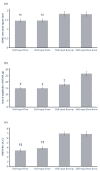Influence of the Amount of Instability on the Leg Muscle Activity During a Loaded Free Barbell Half-Squat
- PMID: 33142906
- PMCID: PMC7672597
- DOI: 10.3390/ijerph17218046
Influence of the Amount of Instability on the Leg Muscle Activity During a Loaded Free Barbell Half-Squat
Abstract
This study aimed to understand the acute responses on the muscular activity of primary movers during the execution of a half-squat under different unstable devices. Fourteen male and female high-standard track and field athletes were voluntarily recruited. A repeated measures design was used to establish the differences between muscle activity of the primary movers, the body centre of mass acceleration and the OMNI-Perceived Exertion Scale for Resistance Exercise (OMNI-Res) in a half-squat under four different stability conditions (floor, foam, BOSU-up and BOSU-down). A significant correlation was found between the highest performance limb muscle activity and body centre of mass acceleration for half-squat floor (r = 0.446, p = 0.003), foam (r = 0.322, p = 0.038), BOSU-up (r = 0.500, p = 0.001), and BOSU-down (r = 0.495, p = 0.001) exercises. For the exercise condition, the half-squat BOSU-up and BOSU-down significantly increased the muscle activity compared to half-squat floor (vastus medialis: p = 0.020, d = 0.56; vastus lateralis: p = 0.006, d = 0.75; biceps femoris: p = 0.000-0.006, d = 1.23-1.00) and half-squat foam (vastus medialis: p = 0.005-0.006, d = 0.60-1.00; vastus lateralis: p = 0.014, d = 0.67; biceps femoris: p = 0.002, d = 1.00) activities. This study contributes to improving the understanding of instability training, providing data about the acute muscular responses that an athlete experiences under varied stability conditions. The perturbation offered by the two BOSU conditions was revealed as the most demanding for the sample of athletes, followed by foam and floor executions.
Keywords: electromyography; perturbation; squatting; unstable.
Conflict of interest statement
The authors declare no conflict of interest. The funders had no role in the choice of research project; design of the study; in the collection, analyses or interpretation of data; in the writing of the manuscript; or in the decision to publish the results.
Figures



References
Publication types
MeSH terms
LinkOut - more resources
Full Text Sources

